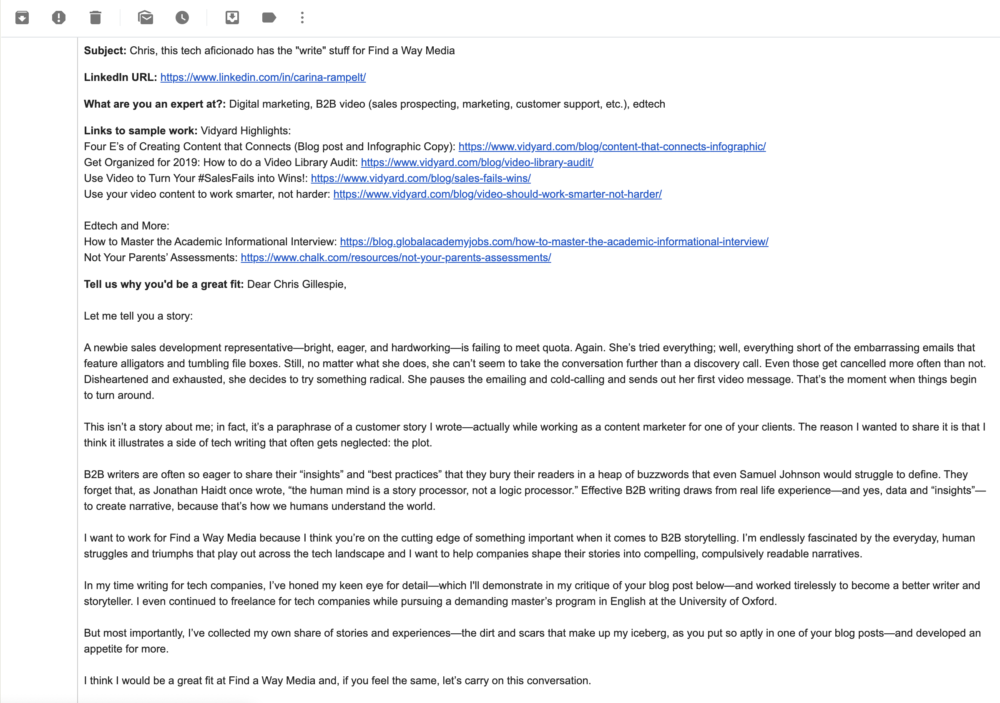I knew the moment the interview finished that I didn’t get the job.
This was starting to become a pattern. “I don’t mean to be cheeky,” another interviewer had told me, “but you’re Canadian. Why would you stay in the UK?”
He had a point. Brexit was looming on the horizon and it cast a shadow of uncertainty in its path, for businesses as well as employees—especially foreign ones.
I wanted to stay in the UK. To me, it seemed like the literary capital of the world and, for as long as I can remember, I’ve wanted to work with words. But, fresh off a master’s degree in English, I found myself stalled.
My job search was coming up empty and my funds—not to mention the days left on my student visa—were running short. In the coup de grâce, I was rejected from a prestigious publishing house the morning I submitted my thesis. I wasn’t sure whether to laugh or cry. (I ended up doing both).
“Why don’t you come watch the cats while we’re away?” my mom, ever the problem-solver, asked me over FaceTime. My parents were going to visit my sister, who was working abroad for an environmental NGO. “It would be a huge help to us.”
And for me, it would provide some much-needed breathing space. So with no job, no plan, and looming student debt, I packed my bags and flew home to Canada to assume the role of cat sitter.
It was time to figure out my next move and I had just two weeks to do it—and three furry companions to watch.
Taking Stock
In those first few days, I spent a lot of time brushing my parents’ fluffy black Maine Coon, Buddy (picture one of Hayao Miyazaki’s soot sprites, but bigger). His long fur always seemed to be full of knots and untangling them gave me time to think.
My options didn’t seem encouraging. Book publishing was stagnating, which explained why my search in the UK had been so fruitless. Journalism looked even worse: More journalists were losing jobs than coal miners.
And then there was academia. I’d always wanted to do a PhD, but I struggled to justify the opportunity cost. It’s an open secret that universities graduate far more PhDs than there are positions for, and I wasn’t sure I was willing to spend 8.2 years getting my doctorate just to have the chance to play tenure-track roulette.
But I couldn’t help feeling a sense of déjà vu. I had been here before. In fact, unsure of what to do while I was saving up for grad school, I had gotten an entry-level job at a software company. I had worked in B2B marketing—that’s business-to-business, for the uninitiated—and had shocked myself by actually enjoying it.
The team I was on generated tons of content to capture the attention of potential customers. I wrote blog posts, e-books, video scripts, and so much more, all with the goal of enticing potential customers with educational content rather than bombarding them with noise.
I knew this approach, known as “inbound marketing,” was gaining traction and marketers needed more high-quality content than ever before. Maybe, just maybe, this was my opportunity.
Write What You Know
I realized I had been so hyper-focused on finding work in book publishing, not because I had a lot of interest in publishing as an industry, but because I liked reading books (and, well, what else are you supposed to do with two English degrees?).
But, as I started investigating B2B writing opportunities, I felt struck with a sense of rightness. “Write what you know” is the sort of cliché they teach you in creative writing classes, but for me, it rang true.
I knew marketers. I got marketers. I understood the stuff they worried about—SEO, CTRs, KPIs. While some people think B2B is boring, I find it endlessly fascinating. For marketers trying to reach their ideal customers, it’s a mix of data and intuition.
It’s art and science (and maybe a little bit of magic). This was a language I felt comfortable speaking and an audience I felt comfortable writing for.

And, despite my grad school hiatus, I had some connections—former colleagues and managers who knew my writing and liked it. And wasn’t there that content agency we used to work with? Soon enough, I had a short list of people who might be interested in my writing to reach out to.
Woo Them With the First Email
Even though I now had a direction, the real challenge was still to come—getting peoples’ attention. Editors and content marketing managers are notoriously busy and get flooded with hundreds of emails a day.
I knew that if I wanted to have a shot at being read, I needed to have something compelling to say.
But this was also an opportunity. I was marketing to marketers. I had the chance to show, not tell, what I could do. If I could entice them to click on my emails, what better proof was there that I could generate compelling content for their readers?
Over the next few days, I carefully crafted my messages. I wrote succinct, individually-tailored notes pitching myself as a freelance writer and letting managers know I was looking for opportunities.
I especially focused on subject lines, knowing that getting the first click was going to be the toughest challenge. Here’s the email I sent to my first client, Chris:.

And here’s what he responded with, 13 minutes later:
In fact, by the time my parents returned from their trip, I had two calls set up with potentially interested clients. In the next few weeks, I landed my big break—a three-month contract with Find A Way Media.
What captured Chris’s attention? I’ll leave that for him to say: “Lots of freelancers try that presumptive ‘day in the life’ story approach, yours is the first one that wasn’t cheesy,” he told me. “You did the same thing as others, but I could tell that you could actually write.”
What I Learned From the Process
Carving out a freelance niche for yourself is no mean feat. Here’s what I learned along the way—and what I wish I had known sooner.
- Write what you know: Your best, most authentic writing comes from real-life experiences. Think about what you’re an expert on—or could develop expertise in—and start there.
- Leverage your network: The people who will be most receptive to your writing are the ones who already know and like your work. Connect with past managers, current or former colleagues, industry connections, friends, and family to see who might be in the market for content. Even if they aren’t, they might be able to introduce you to someone who is.
- Treat your pitch like it’s the most important thing you’ll ever write: Your pitch is your chance to make a great first impression. It’s not only an opportunity to sell a potential client on an idea but also the quality of your writing. Make it concise, compelling, and typo-free.
When I stopped trying to be something I wasn’t and embraced my identity as a B2B writer, finding interesting work became an achievable goal. Today, my cat-sitting days are over (unless my parents want to get away for the weekend, in which case, I’ll happily visit my furry friends).

I have no shortage of interesting writing to keep me occupied. Landing your first freelance writing job is the hardest part—but from there, it has a cascading effect. It makes it that much easier to get the next one and the next after that.
After all, the best sales and marketing is an exceptional product. If you consistently produce excellent writing, people will come back for more.
Keep the conversation going...
Over 10,000 of us are having daily conversations over in our free Facebook group and we'd love to see you there. Join us!





